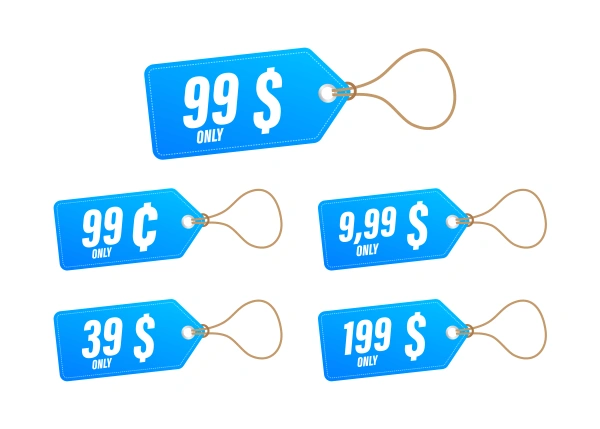How to Increase Profit Margin Using Value-Based Pricing
Businesses often focus on top-line revenue numbers such as revenue and sales growth.
However, these numbers tell you little about a company’s profitability. For example, a company can bring in millions of dollars in revenue each year and be unprofitable.
Some business leaders focus on improving the profit margin of their business. Profit margin is directly related to how much profit a company makes over a reporting period. It is a wonderfully helpful financial metric.
In this article, we will discuss what profit margin is and how it’s calculated. We’ll also look at how you can use value-based pricing to boost your profitability.
What is Profit Margin?
Profit margin is a critical ratio that indicates how much profit a company makes from selling its product or service. It’s expressed as a percentage and is often referred to as a “profitability ratio.”

There are many ways to measure profit margins, each of which tells a slightly different story. This article focuses on strategies to increase gross profit margin, but it’s essential to understand the other types.
Types of Profit Margin
Gross profit margin is a simple way to evaluate your business’s profitability is by using your gross profit margin. To calculate it, take the gross profit, which is the total revenue less the cost of sales, and divide it by revenue.
Net profit margin is a clear reflection of how much profit remains after taxes. It is the net sales ratio to net income. Net profit margin the most accurate insight into your financial health.
Operating profit margin is a measurement of success. It tells if a business is making enough money to be successful. It’s calculated by subtracting a business’ overhead from its gross margin, then dividing the resulting figure by the company’s revenue.
Pretax profit margin is the percentage of revenue that a company retains as profit before paying taxes. It’s determined by deducting the company’s interest expenses from its operating profit, totalling any interest profits, and dividing it by the revenue.
What is a Value-Based Pricing Strategy
Value-based pricing is a means of pricing that centres around the value that a customer places on your product or service.
It’s based on their willingness to pay. Customer pricing is sometimes called customer-focused pricing because it focuses on what the customer values most.
Companies with a value-based pricing strategy must understand how much customers are willing to pay for their products. This understanding is crucial before attempting to sell the product.
The amount that the customer is willing to pay is often depicted in a graphic called a value stick, which illustrates the total value of a product.
The value stick framework helps visualize the components of value-based pricing and methods firms can use to maximize profit margins while creating more value for their customers and suppliers.
Let’s look at each of these components in more detail.
Components of Value-Based Pricing Strategy
1. Willingness to Pay
Willingness to pay (WTP) is the maximum price a customer is willing to pay for your product or service. Companies should charge any amount up to that threshold to make a sale.
Charging even a penny above that number heightens the risk that the customer will decide against purchasing.
When customers make a purchase, they typically feel excitement and joy, and often they will claim the value of that purchase.
The price difference between their initial willingness to pay and the purchase’s final price is customer delight.
It is the amount of goodwill, loyalty, and brand enthusiasm that the customer feels after purchasing. Thus it is often tied to the value they’ve claimed from the transaction.
2. Price
When a business sells a product or service, it charges a price. The price is the final factor in the value stick that a company controls.
It can be set at any point amid a company’s production cost and the customers’ willingness to pay.
When a company sells a product, it must pay attention to the split of revenue between itself and the customer.

The company is responsible for paying its costs for producing the product, but the customer’s willingness to pay is what drives the final price. That is the company’s margin.
Where you price your product determines how profit is distributed between you and your consumer.
Retailers are looking to make money off every sale. They also hope to give customers an excellent value to build brand loyalty and turn a single purchase into a repeat one.
It creates competition over who can give out the most value. Companies need to find the optimal price to win both consumers and profits.
3. Cost
The cost of a product is the total amount of money required to produce it. It includes all of the physical expenses, such as nuts, bolts, widgets, and non-physical expenses, such as rent, utilities, etc.
If a firm can lower its cost, it can offer a higher value to its customers. This competition between the firm and its suppliers works towards driving the price up to maximize their value.
4. Willingness to Sell
Suppliers want to get as much as they can for what they have to offer, but they are willing to negotiate a price.
Their willingness to sell is the lowest price a supplier is willing to accept for his goods or services, which is why products are sold for less than their cost.
What happens when you pay a supplier for his goods? He’s happy to sell, but he’s been gouged by your company.
The difference between the seller’s willingness to sell at a specific price and the cost to your firm is known as supplier surplus. It represents the value the supplier captured from the sale at your expense.
Ways of Increasing Profit Margins with Value-Based Pricing Strategy
As mentioned, gross profit margin is calculated by subtracting the cost of goods sold from revenue.
This formula shows how to increase profit margins for your business in two ways. Either increase revenue or decrease costs — or a combination of the two.
1. Grow Revenue by Increasing Customers’ Willingness to spend
One way to increase revenue is to increase the amount of money customers are willing to spend on a product or service.
By achieving this, businesses can show customers the value they get for the money they spend.
When you sell products to customers, you share the value of the product with them.

The value that customers receive from your product can be measured as the difference between what they are willing to pay and the product’s price.
The value that you receive from your product can be calculated as the difference between the price you sell the product for and the cost of producing it.
Boosting customer satisfaction can be as simple as increasing people’s willingness to pay.
By increasing the price of products and services, you’re able to raise revenue and profit margin while maintaining excitement about the product.
Be sure to improve the product value to justify the price increase.
There are many ways to encourage customers to spend more. It is a compelling strategy to differentiate your product from the competition by adding new features or functionalities.
The product must be redesigned to be more aesthetically pleasing and distinct. Luxury components can make the product a status symbol.
The product should be constructed according to industry standards and norms, such as environmental or fair-trade regulations. These features make the products premium goods.
2. Decrease Costs by Lowering Suppliers’ Prices
When trying to drive costs down, the first thing you should do is work with your suppliers to get their prices as low as possible.
When you purchase a product, component, or service, the supplier is motivated to charge as much as possible to maximize profits.
On the other hand, your company is encouraged to reduce expenses to maintain profitability while still distributing the value equitably to end customers.

To improve your profit margins, you might lower your supplier’s willingness to sell which can be tougher to achieve than increasing your customer’s willingness to pay. Some strategies for doing so might include:
Purchasing in bulk: A supplier will cut its price per piece because it has a more significant total revenue from the bigger volume.
Obliging to forthcoming contracts: A supplier may be happy to reduce their prices if you promise to be a trustworthy and dependable business source in the future.
Conclusion
Value-based pricing will benefit all parties involved in a transaction. The benefit can be potentially threefold.
While higher margins can help your business, you need to provide more excellent value to your customers to increase their willingness to pay.
By increasing customer loyalty and referrals, you can build your business’s reputation, and that’s a great asset, too.
About the Author
Eugen Spivak is a multi-award-winning author, business strategist, and a business coach. Eugen is the founder of the Canadian Institute of International Business, an organization focused on a better way to learn business!
Study With Us!
We offer practical courses in various areas of business. Our instructors have at least 10 years of practical experience in their fields.



